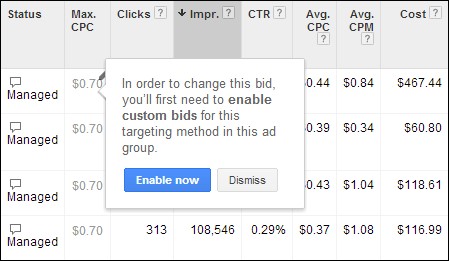7 Common Pitfalls Of Google Display Network Campaign Management
The Google Display Network has been around for a long time now, yet marketers continue to make many of the same mistakes over and over again. Here are seven common issues that can arise when running a display campaign if you don’t stay on the ball. 1. Unnecessary Pausing Of Keywords You notice that your display […]
The Google Display Network has been around for a long time now, yet marketers continue to make many of the same mistakes over and over again. Here are seven common issues that can arise when running a display campaign if you don’t stay on the ball.
1. Unnecessary Pausing Of Keywords
You notice that your display campaign has suddenly started spending a lot more money and your cost-per-conversion has tripled. What’s the first thing you look at?
A lot of people would tend to go straight to the keywords (if targeting contextually) and try to pinpoint the highest spending term to either lower the bid on it or pause it. This is the wrong place to be looking.
If you notice a high surge in spend, always go to your placements tab and evaluate the domains your ads have been showing on. One keyword may well have triggered an irrelevant or new placement, but this doesn’t mean that the keyword needs to be paused.
Often, you can either exclude the placement or add a bid multiplier to it to positively or negatively impact its bid. Don’t forget to look back over a longer time period to see if there are any placements that have been underperforming for a long time — these can be excluded.
2. Not Adjusting Keyword Level Custom Bids
As part of the Enhanced Campaigns rollout last year, Google added a new feature whereby you could apply custom bids to one of your targeting methods and then use bid adjustments to further refine bids for your other combination targeting methods.
If you haven’t changed your keyword-level bids since then, you’ll notice that when you do, it won’t let you until you enable custom bids on them. If you hadn’t made the choice, AdWords will have taken your ad group level bid at the time.

How to enable custom bids
Switch on custom bids at keyword level and start optimizing each keyword! Once you’ve assessed the types of placement coming in at keyword level, you’ll have a better idea of which keywords are performing well (or not).
From here, you can adjust your bids to achieve better results overall. Too often, marketers forget to regularly adjust their keyword-level bids on display campaigns. If you’re not working toward direct response, you can still be adjusting bids to try to gain maximum traffic for your budget.
3. Not Making Use Of Bid Adjustments
Related to the above point, bid adjustments often get overlooked!
You can only set your custom bid for one targeting method; if you’re doing keyword targeting, you’ll need to choose this as your custom bid as bid adjustments (by %) can’t be made in the keywords tab.

How to change bid adjustments for your targeting methods
If you’re doing combination targeting, you’ll want to make regular bid adjustments based on performance to either bid a specified percentage more or less for certain placements, topics or interest categories.
Google has made things much easier for us to further refine our combination bidding, so start taking advantage of it.
4. Having A Static Strategy & Structure
When was the last time you added a new ad group to your display campaign? A while ago? Thought so! Our search campaigns evolve with time, and we’re always adding in new features — but people can forget to do the same with the GDN.
Model your display campaign on David Beckham’s strategy: change and adapt with the latest trends, or set them yourself to stay ahead of the competition!

Test new approaches as often as Beckham changes his hair style.
- Make sure you’re testing out new options available to you such as in market segments and affinity categories which give you increased coverage for your campaigns but a more niche-level of targeting.
- Experiment with bid multipliers for location, device, time-of-day and age, and expand your strategies based on these results. You’ll almost certainly be looking into these different bidding strategies for your search campaigns, so don’t neglect them in your display campaigns!
- Expand your keyword lists; display ad groups have the same limits as search ones now, so you’re no longer capped at 50 keywords.
This next one takes the biscuit for the worst common mistake!
5. Only Utilizing Image Ads
Marketers often forget about text ads — at their own peril. If you’re not utilizing text ads, that means you’re not gaining full exposure on the GDN, as a significant number of sites only allow text ads to be shown.
Text ads have been shown to give great direct response, so they are definitely worth adding into your campaigns. Keep up-to-date with the latest developments in this area, too, as there are some exciting changes coming which will impact the look and feel of text ads!
6. Not Testing Ads
This is another common pitfall, and display campaigns sadly get overlooked in this area. It’s important to test:
- Different sets of image ads
- At least three text ads per ad group
- A variety of image ad sizes (including the newer half page and mobile ads)
- Different styles of image ads such as the new engagement style ads
These are just a few ideas of things to look at, but you get the idea.
For those with a particularly static display campaign, image ads can now be up to 150kb in size, so you can get some much better quality image ads in your account now compared to the 50kb limit that had been set in the past!
7. Expecting The Same Results As From Search Campaigns
Display campaigns can be short lived, if you approach them with the wrong expectations. When starting up a GDN campaign, you need to approach it with the understanding that it will not yield the same results as your search campaigns.
Clickthrough rates will be lower, conversion rates will be lower, the volume of conversions will be lower, etc. You need to launch your campaign with a goal of either raising awareness or trying to gain direct response — and if you’re looking for direct response, you’re going to need to set different goals than those of your main search campaigns.
The GDN will give you that additional reach you need whilst also offering you a lower cost-per-click in many cases compared to your main search campaigns, but you’ll need to continually experiment with all the options available to you to make it work in the right way for you. Don’t give up — keep testing new things!
To Sum Up
There are more common mistakes, but these are some of the main ones I come across when looking at display campaigns that come to the agency where I work.
Display isn’t just something you switch on and leave running, it’s something that takes a lot of fine tuning to get working the way you want it to, and with that, you need to make sure you’re giving it enough attention and budget in relation to your search campaigns. If you’re not running any GDN campaigns yet, hopefully, this will give you a few pointers ahead of getting started!
Photo Image Credit: archives.deccanchronicle.com
Contributing authors are invited to create content for Search Engine Land and are chosen for their expertise and contribution to the search community. Our contributors work under the oversight of the editorial staff and contributions are checked for quality and relevance to our readers. The opinions they express are their own.
Related stories
New on Search Engine Land